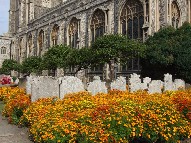| |
|
St Peter
and St Paul, Cromer
 |
|
Norfolk
and Suffolk are in many ways two sides of the
same coin, but nothing sets them apart quite so
much as the difference between their coastlines.
The coast of Suffolk is secretive and wild, not
least because there is no coastal road. The A12
comes pretty near to the sea as it approaches
Lowestoft, but apart from that you need to come
inland along often windy, narrow lanes, to reach
one part of the coast from another. For example,
to get by car from Walberswick to Southwold, two
pretty resorts which face each other across the
mouth of the River Blyth, requires a journey of
nearly ten miles. Apart from South Lowestoft, one
of Suffolk's best kept secrets, there are no
beautiful sandy beaches, and only Felixstowe
really fits the bill of being a traditional
seaside resort. But Norfolk was built for
seaside holidays, and of all its resorts I love
Cromer best. Cromer has a wide, sandy beach with
a gentle incline, rock pools, cliffs, a pier, a
children's fairground, narrow streets,
old-fashioned pubs, fishermen's huts, a
secondhand bookshop, local shops, and the smell
of crabs - it is the Ladybird Book of the
Seaside come to life. We love it. On a
bright sunny day in early autumn, there's nowhere
we'd rather be.
|
You can
tell a lot about a town by the efforts its medieval
church goes to to be welcoming. While all the churches in
the Yarmouth and Hemsby area appear to be kept locked
most of the time, Cromer church is militantly open every
day, and you can never be alone inside it. People passing
by just wander inside, holiday-makers go in to explore,
and best of all you can go up the tower, which is East
Anglia's tallest. It has become one of the resort's
attractions. Unlike many Norfolk town churches, the
congregation here is low church in character, and so they
are to be thanked and congratulated for allowing their
building to be open for private prayer and meditation.
Pevsner's
entry for St Peter and St Paul begins Externally a
very impressive church, and you can hear what's
coming. Several paragraphs later, he notes that the
interior, after so much display, is a little
disappointing, but there is good reason for this.
Cromer had been one of the prosperous north Norfolk ports
in the late Middle Ages, and it is the only one of them
which retains anything like the same significance. But
the post-Reformation period, and its suspicion of Europe,
brought hard times to this remote place. Much of the
eastern end of the church collapsed in the 17th century,
and serious consideration was given in the 1780s to
demolishing the whole thing. It wasn't until the Anglican
revival of the second half of the 19th century that
attention was paid to restoring St Peter and St Paul to
full use, under the direction of Arthur Blomfield, an
architect who was generally a safe pair of hands, if not
terribly exciting ones. He rebuilt the chancel,
refashioned all the window tracery, and restored the
tower and porch, which nonetheless are all that survive
in their original state. The chancel would once have been
longer, and in proportion is not entirely successful now.
Inevitably, you step into what is essentially a 19th
century building.
The vast
windows flood the great, lofty nave with light, and
offset some excellent modern glass on the south side.
Abstract lozenges commemorate various members of the
lifeboat crew, and depict lifeboats as well as other
features of the resort, including the lighthouse and
buckets and spades.The distorted clear glass in which
they are set creates a fine effect.
| The
truncated chancel makes the east window rather
imposing. Blomfield apparently based its
proportions and tracery on what was there before,
but of course it had been set further to the
east. The glass by Hardman & Co is good. The
best glass is in the east window of the south
aisle, by Morris & Co to the design of Edward
Burne-Jones. It was damaged in an air raid in
1942, but has been fully restored. The west
window contains AL Wilkinson's dramatic depiction
of the Ascension. Apart from the glass, there
isn't a huge amount to see, beyond the sheer
drama of the soaring arcades and the vast tower
arch, its proportions somewhat compromised by
what is an undeniably attractive ringers platform
with meeting room beneath. You step through here
to climb the steps to the top of the tower, from
which the view is spectacular, especially on a
clear day, although I always find my vertigo
kicking in when I stand on the raised decking,
which at the centre of the tower is higher than
the parapet. And then, down into the lovely town
below.
|
|
 |
|
|
|
